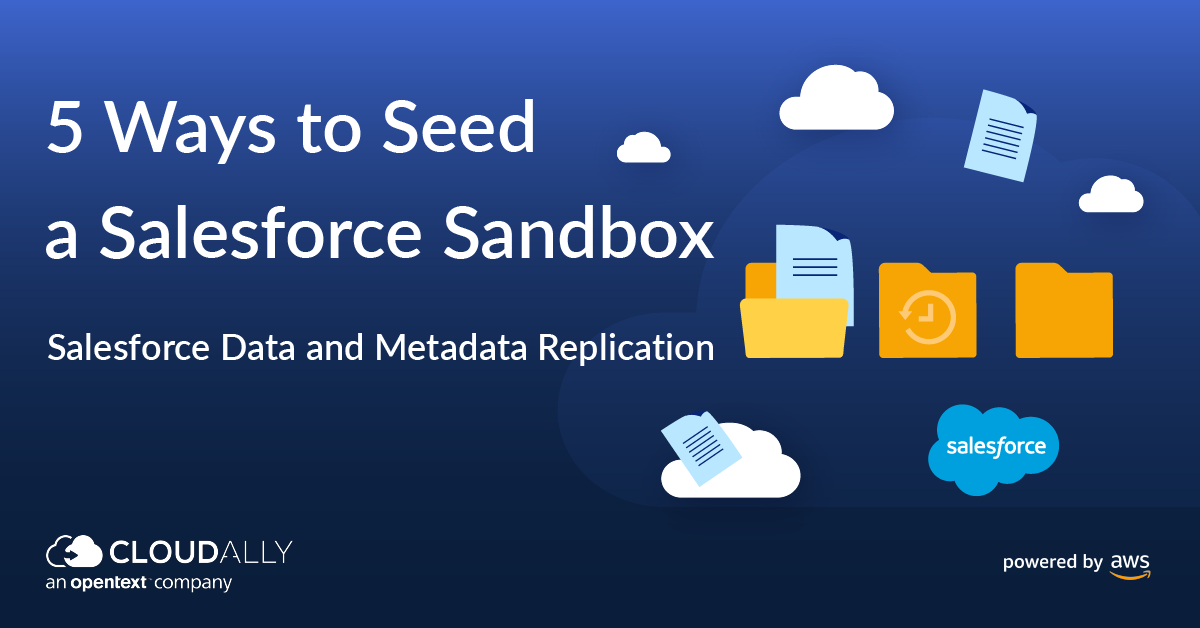Quality Assurance (QA) best practices advise that tests be run against “production-like” data, but they also strongly mandate that no testing or development should be done in production. The way out? Replicating Salesforce data – seeding real-world data by copying from production to sandbox. Salesforce Sandbox testing satisfies both best practices – testing with a copy of actual production data, but in the safe confines of the sandbox. Here we detail 5 ways to replicate Salesforce data by triggering a copy from production to sandbox.
How to Replicate Salesforce Data? Sandbox Seeding 101
#1 Native Method: Using Data Loader to Copy Data from Production to Sandbox
The Salesforce Data Loader App is a native Salesforce client application that enables you to export production data. It is a multi-step process where you first have to export production data to a comma-delimited file (CSV). After that use that Excel file to populate your sandbox.
Limitations: It is very time-consuming. Also, records with complex relationships, such as those with intra-object relationships and multiple parents, are erroneously recreated. You would need to have a thorough understanding of the data schema to fix these relationships. Another issue is dealing with duplicates that have to be manually removed.
#2 Sandbox Refresh to Copy Metadata from Production to Sandbox
Refreshing the sandbox copies the metadata afresh from the source org. To replicate both the metadata and data afresh, the sandbox has to be a clone or use a sandbox template. Note that if you didn’t select Auto Activate while refreshing your sandbox, you must activate your sandbox before you can use it.
Limitations: Time-consuming – refreshing a medium-sized sandbox to copy the production data afresh can take a few days.
#3 Templating: Sandbox Cloning for a Production-like Template
Cloning a sandbox is helpful when you need to seed multiple instances of sandboxes and want to skip the considerable wait time of doing so. Simply create a sandbox with your desired data and metadata and then proceed to only replicate that sandbox. That way each team can work with a separate sandbox with production-like data without any mixups.
Limitations: The clone may require significant tweaking to have data relevant to your specific needs, which defeats the purpose of templatizing the cloning process.
#4 ETL Testing
Extract-Transform-Load (ETL) testing is typically used in data warehousing projects but can be also used to bulk copy data from production to sandbox. Create scripts to copy data from your production org and populate your sandbox org with the data.
Limitations: Size limits can be an issue, and data has to be filtered to avoid it. Here too, not all data is copied as-is and will require complex SQL queries when comparing the data.
#5 Salesforce Seeding Tools from AppExchange
Manual Sandbox Seeding is time-consuming, tedious, and error-prone. Moreover, it is labor-intensive and requires dedicated tech effort. A third-party tool from AppExchange can copy your data over from production to a sandbox with a few clicks. CloudAlly Backup for Salesforce includes Sandbox Seeding at no extra cost.
Replicate Salesforce Data Reliably, Accurately, and Quickly
Copy your data from Production to Sandbox in minutes with a few clicks in an automated manner with Salesforce Sandbox seeding (replication). Quicken your development and QA cycles with optimized test data. Reduce admin workload with out-of-the-box support for Salesforce sandbox seeding.
Watch how to Replicate Metadata at the Granular Object Level
Benefits of CloudAlly Salesforce Backup with Replication Included:
- Reduce costs: Obtaining a full copy of a Salesforce sandbox for manual seeding and is expensive. Save by automated seeding with filters for relevant data.
- Improve quality: Efficiently seeding relevant data into a sandbox is a challenge. Picking the right data set is easy with support for preset filters, excluding attachments, and disabling triggers.
- Reduce errors: Developers cannot fully test when limited to partial data, which can allow bugs and errors to slip into production. CloudAlly supports large data set replication.
- Save effort: Manually preparing a sandbox test data set can take hours or even days, which can mean corners are often cut in the development and QA process. Get it out-of-the-box with CloudAlly.
- High ROI with bundled features: Get all the above benefits of error-free and easy Sandbox seeding along with automated and secure Salesforce backup and recovery with a few clicks. Salesforce compare, a powerful tool where you can compare data or metadata across backups and/or the production Salesforce database, and Anomaly detection where you get notified of potential data loss red flags are also included.
Start a free trial NOW! No payment details required, 5-min setup (honest!), zero commitment.
Want to learn how to protect your Salesforce data? Get certified in Salesforce SaaS Data Protection with insights from 8X Salesforce MVP, Francis Pindar. This course features best practices, expert advice, and practical labs. Enroll today—it’s free for a limited time!




